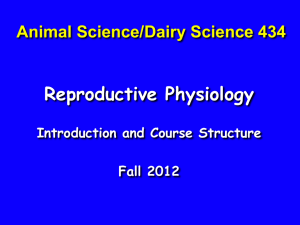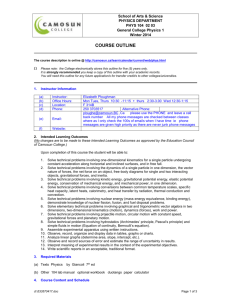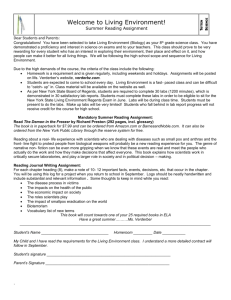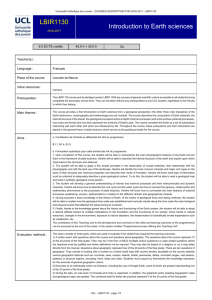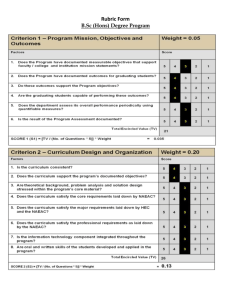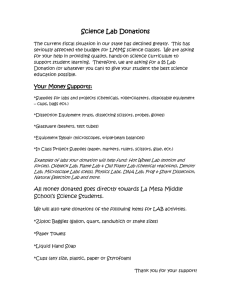GEOS-100-002 Tark Hamilton
advertisement
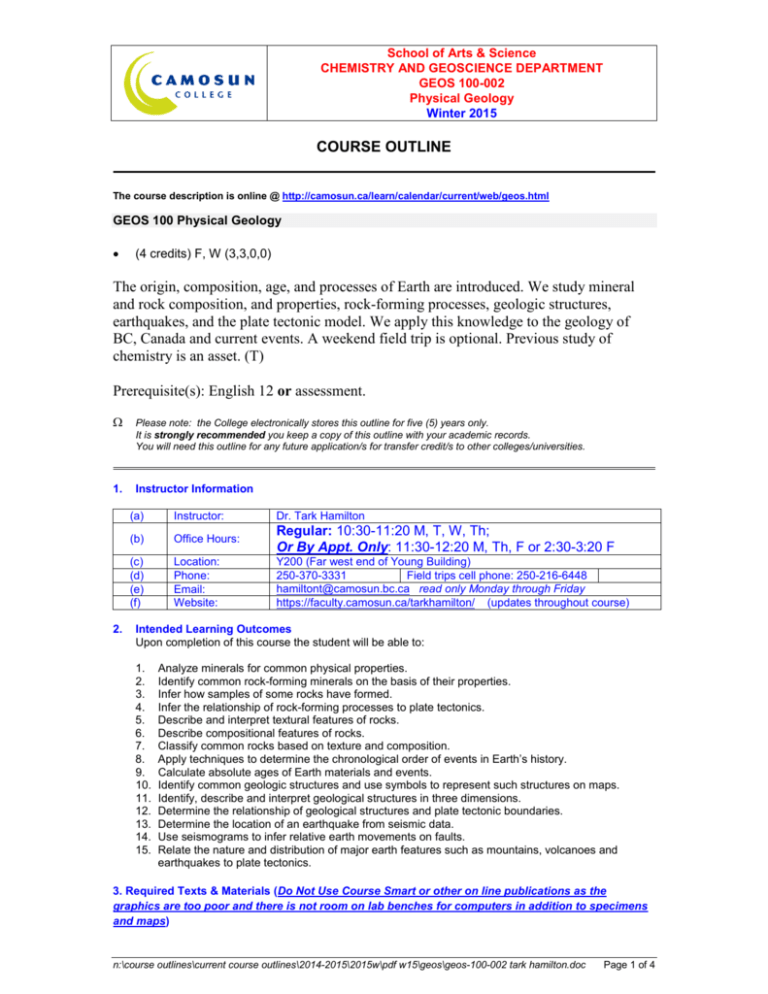
School of Arts & Science CHEMISTRY AND GEOSCIENCE DEPARTMENT GEOS 100-002 Physical Geology Winter 2015 COURSE OUTLINE The course description is online @ http://camosun.ca/learn/calendar/current/web/geos.html GEOS 100 Physical Geology • (4 credits) F, W (3,3,0,0) The origin, composition, age, and processes of Earth are introduced. We study mineral and rock composition, and properties, rock-forming processes, geologic structures, earthquakes, and the plate tectonic model. We apply this knowledge to the geology of BC, Canada and current events. A weekend field trip is optional. Previous study of chemistry is an asset. (T) Prerequisite(s): English 12 or assessment. Ω 1. 2. Please note: the College electronically stores this outline for five (5) years only. It is strongly recommended you keep a copy of this outline with your academic records. You will need this outline for any future application/s for transfer credit/s to other colleges/universities. Instructor Information (a) Instructor: Dr. Tark Hamilton (b) Office Hours: Regular: 10:30-11:20 M, T, W, Th; Or By Appt. Only: 11:30-12:20 M, Th, F or 2:30-3:20 F (c) (d) (e) (f) Location: Phone: Email: Website: Y200 (Far west end of Young Building) 250-370-3331 Field trips cell phone: 250-216-6448 hamiltont@camosun.bc.ca read only Monday through Friday https://faculty.camosun.ca/tarkhamilton/ (updates throughout course) Intended Learning Outcomes Upon completion of this course the student will be able to: 1. 2. 3. 4. 5. 6. 7. 8. 9. 10. 11. 12. 13. 14. 15. Analyze minerals for common physical properties. Identify common rock-forming minerals on the basis of their properties. Infer how samples of some rocks have formed. Infer the relationship of rock-forming processes to plate tectonics. Describe and interpret textural features of rocks. Describe compositional features of rocks. Classify common rocks based on texture and composition. Apply techniques to determine the chronological order of events in Earth’s history. Calculate absolute ages of Earth materials and events. Identify common geologic structures and use symbols to represent such structures on maps. Identify, describe and interpret geological structures in three dimensions. Determine the relationship of geological structures and plate tectonic boundaries. Determine the location of an earthquake from seismic data. Use seismograms to infer relative earth movements on faults. Relate the nature and distribution of major earth features such as mountains, volcanoes and earthquakes to plate tectonics. 3. Required Texts & Materials (Do Not Use Course Smart or other on line publications as the graphics are too poor and there is not room on lab benches for computers in addition to specimens and maps) n:\course outlines\current course outlines\2014-2015\2015w\pdf w15\geos\geos-100-002 tark hamilton.doc Page 1 of 4 a. Text: Canadian Edition Earth: An Introduction to Physical Geology, E.J. Tarbuck, F.K. Lutgens, C.J. rd Tsujita & S. R. Hickock 4 ed. Prentice Hall 2014 (978-0-321-93701-8) or earlier editions. (Note: Compared to the American version this has >40% new content and Canadian examples. All of my st test questions are based on this text. I am the author of the testbank. The 1 edition without Hickock is more thorough. b. Lab Manual in Physical Geology: American Geological Institute/Laboratory Manual is 10th edition (978th 0-321-94451-1). Ensure if you buy a used copy 10 edition that all of the mineral and rock tables and templates at the back and figures are still attached. The content differs too much to use older editions so th th please do not buy them. My weekly lab exercises are keyed to the 10 edition only. Please note that the 9 or older editions differ in many questions and page calls so they are not adequate for doing the weekly labs. For example my weekly lab instructions might read: Look at figure 1.16a on p.89 and answer question 3d and 3e. In earlier editions this will lead you to the wrong page, wrong figure and might not even have a question 3e. c. Recommended reading of other geology texts, a geological glossary (dictionary), a mineral identification book and web based research, readings, real and virtual field trips. Mygeoscience Place Pearsoned. Earth: Animations Library, Log into My Geospace once you register your new text book. Here is a link for tectonics, tsunami, planetary rotation etc.: http://www.pearsoned.ca/highered/mygeoscienceplace/geo_ani.html http://earthobservatory.nasa.gov/IOTD Weekly additions and archives of space station or satellite digital images of geological events and features around the globe. I put up specific links on the course website and there is lots of archival and searchable material for past geological events: volcanic eruptions, hurricanes, landslides, glaciers, etc. d. Other Hand lens (needed in first 4 labs, Mineral and Rock quizzes and for field trips), protractor, drawing compass, coloured pencils (all needed for labs 4 onward for labeled drawings and colouring thin section sketches, maps and cross sections). 2 half day weekend field trips are required as scheduled below and announced 2 weeks in advance. These integrate your course learning with field observations. These and any field trips during lab periods will require your signed waviers to participate. One wavier does it for the whole term. 4. Course Content and Schedule Instruction 14 weeks: Jan 5 - April 10 a. Classroom Lecture 3 hours 11:30-12:20 Tue, Wed - F200 & 1:30-2:20 Fri- F210 b. Lab 3 hours Mon – 12:30 - 3:20 PM F300 (Lab attendance is mandatory, you must pass the lab to pass the course). Please come to labs on time as there is often an introductory lecture to get you started, a quiz or a field trip, none of which will help you if you miss them! Most Labs are due at the beginning of the following lab period the week following their issue. Your section is first and with prior permission, you might be able to attend the other lab section Thursday at 2:30-5:20. There are no make-up labs. Access to the Geoscience Lab and its rocks, maps and displays F300 is limited, use your lab time efficiently, most labs require 1 hour of reading prior to coming to the lab & 2-3 hours after the lab on your own or with your partner to complete the exercises & report. c. Local Field Trips during lab time & 1 or 2 weekend 1 day trips are required. My reminder in lecture gives 2 weeks notice. Field trips count the same as 1 lab towards your lab mark. Tentatively a field trip is scheduled for Monday February 23 in your regular Lab period and also for Sunday March 22 ~8AM-2PM to East Sooke Park and Muir Creek. Labs, Tests & Midterm Schedule: Holidays: Feb. 9 Family , 12-13 read, April 3-6 Eostre Lab Date 1. Jan 5 Experiment Lecture in Lab Pre-Lab Reading Earth 1-29 plus Ch 11, 12, 13 n:\course outlines\current course outlines\2014-2015\2015w\pdf w15\geos\geos-100-002 tark hamilton.doc Page 2 of 4 2. Jan 12 Lab 1: Units, Density and Isostasy 1-24 & Lab Form 3. Jan 19 Lab 2 Plate Tectonics 39-54 & Lab Form 4. Jan 26 Lab 3 Minerals 73-100 & Lab Form 5. Feb 2 Finish Lab 3 Minerals & Lab 4 Rock Cycle 73-100 & 111-120 LF 6. Feb 9 Theory Test 1 & start Lab 5 Igneous Rocks 129-142 & Lab Form st 7. Feb 16 Min Quiz 1 1.5 hours & hand in Lab 5 Igneous Rocks 129-142 & Lab Form 8. Feb 23 Field Trip in Lab: Cattle Point – Harling Point – Finlayson Point 9. Mar 2 Lab 6 Sediments & Sedi Rocks 153-170 & Lab Form 10. Mar 9 Hand in Lab 6 Sed & Start Lab 7 Metamorphic Rocks 187-198 & Lab Form 11. Mar 16 Hand in Meta, & Start Time Lab 8 Finish as Home Work 207-216 & Lab Form Sunday March 22 Field Trip: Sooke & Muir Creek 12. Mar 23 Theory Test 2 & Lab 16 Earthquakes 391-396 & Lab Form st 13. Mar 30 Rock Quiz in 1 1.5 hour Lab 10 Structures (part 1) 259-272 & Lab Form 14. Apr 6 Finish & Hand in Lab 10, Wapiti Pass Map, Models 1-6 Field Trip: depart Camosun staff parking lot by the Wilna Thomas Building at 8:00 AM Sunday March 22 scheduled for low tide at East Sooke Park & Muir Creek pending availability of Camosun Bus and driver. Drivers and Car Rides are arranged by sign up in lecture 1 week in advance. st • Mineral and Rock Practical Identification Quizzes in 1 part of lab weeks 7 & 13 (no late starts) •Theory exams in Weeks 6 and 12 •Final exam at the end of the course is cumulative and will cover all course & lab material. Don’t make travel arrangements for the final exam period December 8-16. Only medical excuses will be allowed. •At least a passing grade on lab marks must be achieved in order to write the final exam. •You must pass both the lecture portion and the lab portion in order to pass the course •Students are expected to come to lab on time – late arrivals will miss tests, quizzes or field trips as these begin promptly at the start of lab period. Prelab readings and assignments in AGI manual are due as you walk in the lab door. Without them you cannot do the lab. There is not time to read ~20 pages and to do the lab in the lab period. •All lab reports must be stapled with your section number or lab day and time and your partner’s name. All lab reports are joint projects of 2 people, these labs require partners for concepts, measurements, calculations and interpretations. 5. Basis of Student Assessment (Weighting) (This section should be directly linked to the Intended Learning Outcomes.) (a) Lab exercises (due in lab at the beginning of the following lab period see schedule above) Labs 3 and 10 count double as they are 2 week labs. There will usually not be time to work on old labs as there will always be new work assigned. You must attend and pass the lab to pass this course. The lab and field trips are where the scientific inquiry occurs. (b) 2 Lab quizzes during 1st hour of lab period No Late Starts! Along with regular lab assignments in weeks: 7 covering: (mineral physical properties, formulas & identification) 5%, weeks 13 (rock identification and origin) 5%. Labs and lab tests combine to 25% of course. Lab marks are relative to your peers and the overall point total. Most people’s lab marks pull up their course mark. (c) Midterm exams covering theory in weeks: 6 and 12 (no late starts!) Written exams 1: 15%, 2: 25%: covering lectures through week prior to test. (d) Weekly pop quizzes on assigned readings, new geological vocabulary terms and prior lecture notes may occur at beginning of Tuesday class. Used for attendance for me & a wake-up call for you! (e) Final exam cumulative in week of April 13 or 20 = 35% as scheduled on Camlink by Feb 21. No make ups or early departures. (f) I have a 1 test forgiveness policy for those who improve their test scores as the term progresses. For example, if you do better on the final exam than a prior exam I will replace the lower mark and its proportion with the mark from your final exam. 6. Grading System Standard Grading System (GPA) n:\course outlines\current course outlines\2014-2015\2015w\pdf w15\geos\geos-100-002 tark hamilton.doc Page 3 of 4 Percentage Grade 90-100 85-89 80-84 77-79 73-76 70-72 65-69 60-64 A+ A AB+ B BC+ C 50-59 D 0-49 F Description Grade Point Equivalency 9 8 7 6 5 4 3 2 Minimum level of achievement for which credit is granted; a course with a "D" grade cannot be used as a prerequisite. Minimum level has not been achieved. 1 0 Temporary Grades Temporary grades are assigned for specific circumstances and will convert to a final grade according to the grading scheme being used in the course. See Grading Policy E-1.5 at camosun.ca for information on conversion to final grades, and for additional information on student record and transcript notations. Temporary Grade I IP CW 7. Description Incomplete: A temporary grade assigned when the requirements of a course have not yet been completed due to hardship or extenuating circumstances, such as illness or death in the family. In progress: A temporary grade assigned for courses that, due to design may require a further enrollment in the same course. No more than two IP grades will be assigned for the same course. (For these courses a final grade will be assigned to either the rd 3 course attempt or at the point of course completion.) Compulsory Withdrawal: A temporary grade assigned by a Dean when an instructor, after documenting the prescriptive strategies applied and consulting with peers, deems that a student is unsafe to self or others and must be removed from the lab, practicum, worksite, or field placement. Recommended Materials or Services to Assist Students to Succeed Throughout the Course LEARNING SUPPORT AND SERVICES FOR STUDENTS There are a variety of services available for students to assist them throughout their learning. This information is available in the College calendar, at Student Services, or the College web site at camosun.ca. STUDENT CONDUCT POLICY There is a Student Conduct Policy which includes plagiarism. It is the student’s responsibility to become familiar with the content of this policy. The policy is available in each School Administration Office, at Student Services, and the College web site in the Policy Section. No eating or drinking is allowed in laboratories in Fisher 300 as this space is also used for chemistry experiments. n:\course outlines\current course outlines\2014-2015\2015w\pdf w15\geos\geos-100-002 tark hamilton.doc Page 4 of 4
